It looks like you're using an Ad Blocker.
Please white-list or disable AboveTopSecret.com in your ad-blocking tool.
Thank you.
Some features of ATS will be disabled while you continue to use an ad-blocker.
share:
reply to post by JadeStar
Not to detract from the OP, but ATS would be better served if you started your own thread. I realize you've already done a lot of work in this thread, but your work is being overlooked. You have gone above and beyond and I feel like the information you are presenting (along with it's context) should be flagged for all of ATS to see.
Not to detract from the OP, but ATS would be better served if you started your own thread. I realize you've already done a lot of work in this thread, but your work is being overlooked. You have gone above and beyond and I feel like the information you are presenting (along with it's context) should be flagged for all of ATS to see.
reply to post by 5pooky
Had the pleasure of meeting Betty back in the 90s at a UFO symposium in Portsmouth NH. My (now-ex) wife and I sat and chatted with her and the two of them had a smoke during a break in the conference. She couldn't have been any nicer.
Had the pleasure of meeting Betty back in the 90s at a UFO symposium in Portsmouth NH. My (now-ex) wife and I sat and chatted with her and the two of them had a smoke during a break in the conference. She couldn't have been any nicer.
DeadSeraph
reply to post by JadeStar
Not to detract from the OP, but ATS would be better served if you started your own thread. I realize you've already done a lot of work in this thread, but your work is being overlooked. You have gone above and beyond and I feel like the information you are presenting (along with it's context) should be flagged for all of ATS to see.
Thank you. Like i said, I will put this all in its own thread soon when I finish the video tour/summary. That way everything will be in one nice concise place and it will stand out. Patience
Aero1
reply to post by 5pooky
Had the pleasure of meeting Betty back in the 90s at a UFO symposium in Portsmouth NH. My (now-ex) wife and I sat and chatted with her and the two of them had a smoke during a break in the conference. She couldn't have been any nicer.
Did you go on a podcast or radio show? I remember hearing someone say the same thing about her in the same context (they met when going out for a smoke break).
reply to post by JadeStar
Nope, wasn't me. Betty was a heavy smoker though, so not surprising others had similar sit-dows with her. What many people don't know is that she had many UFO sightings throughout her life, right there in Exeter. She wrote a book on the subject called A Common Sense Approach to UFOs. Not a large volume, but interesting nonetheless. Got a signed copy of it somewhere.
Nope, wasn't me. Betty was a heavy smoker though, so not surprising others had similar sit-dows with her. What many people don't know is that she had many UFO sightings throughout her life, right there in Exeter. She wrote a book on the subject called A Common Sense Approach to UFOs. Not a large volume, but interesting nonetheless. Got a signed copy of it somewhere.
It seems that Zeta 2 Reticuli is the star on which the civilization could be based. Lines radiate from it to Zeta 1 Reticuli, and to other stars, but
not from Zeta 1 to other stars. Perhaps Zeta 2 is a bit further along in its stellar evolution, and so enabled civilization to arise first on one of
its supposed planets. I note that Zeta 2's mass, luminosity, and temperature are all somewhat higher than those of Zeta 1, which would seem to
support this idea.
Ross 54
It seems that Zeta 2 Reticuli is the star on which the civilization could be based. Lines radiate from it to Zeta 1 Reticuli, and to other stars, but not from Zeta 1 to other stars. Perhaps Zeta 2 is a bit further along in its stellar evolution, and so enabled civilization to arise first on one of its supposed planets. I note that Zeta 2's mass, luminosity, and temperature are all somewhat higher than those of Zeta 1, which would seem to support this idea.
No, actually it was Zeta 2 that ended up with a debris disk and the "ability" to grow planets, Zeta-1 apparently wasn't so lucky.
Other than that the two seem close enough that they each could have life, planets, etc...Ahhh for the roll of the dice! Good ole probability strikes yet again.
We can't assume that a star without a known debris belt has no planets. A study published in 2009 found that of 146 stars where one or more planets
had been discerned, only 28 were found to have currently detectable debris belts. I surmise that Zeta 1 Reticuli could have planets, but that
interactions with the largest of these could have scattered debris belt material so widely and thinly that we can't observe it .
reply to post by DeadSeraph
I've been begging her to start her own thread as well. It will happen soon. Maybe one day this star map will be called the JadeStar-Fish-Hill Star Map?
I've been begging her to start her own thread as well. It will happen soon. Maybe one day this star map will be called the JadeStar-Fish-Hill Star Map?
Ross 54
We can't assume that a star without a known debris belt has no planets. A study published in 2009 found that of 146 stars where one or more planets had been discerned, only 28 were found to have currently detectable debris belts. I surmise that Zeta 1 Reticuli could have planets, but that interactions with the largest of these could have scattered debris belt material so widely and thinly that we can't observe it .
No, actually, all I'm saying is that is one of the only significant differences. Both stars are "G" class, one is a bit brighter is all, and, its not really all that much. (I've been working on a way to graphically visualize the different classes and luminosities, have worked it all out yet).
So, yes, Zeta-1 could have planets. But, current science says probably not, and the Star Map shows no route directly to Zeta-1.
Coursework and my job slowed me down a little. I will try to post some more things tonight but for now I will leave you with a riddle.
What do you think this map is showing?
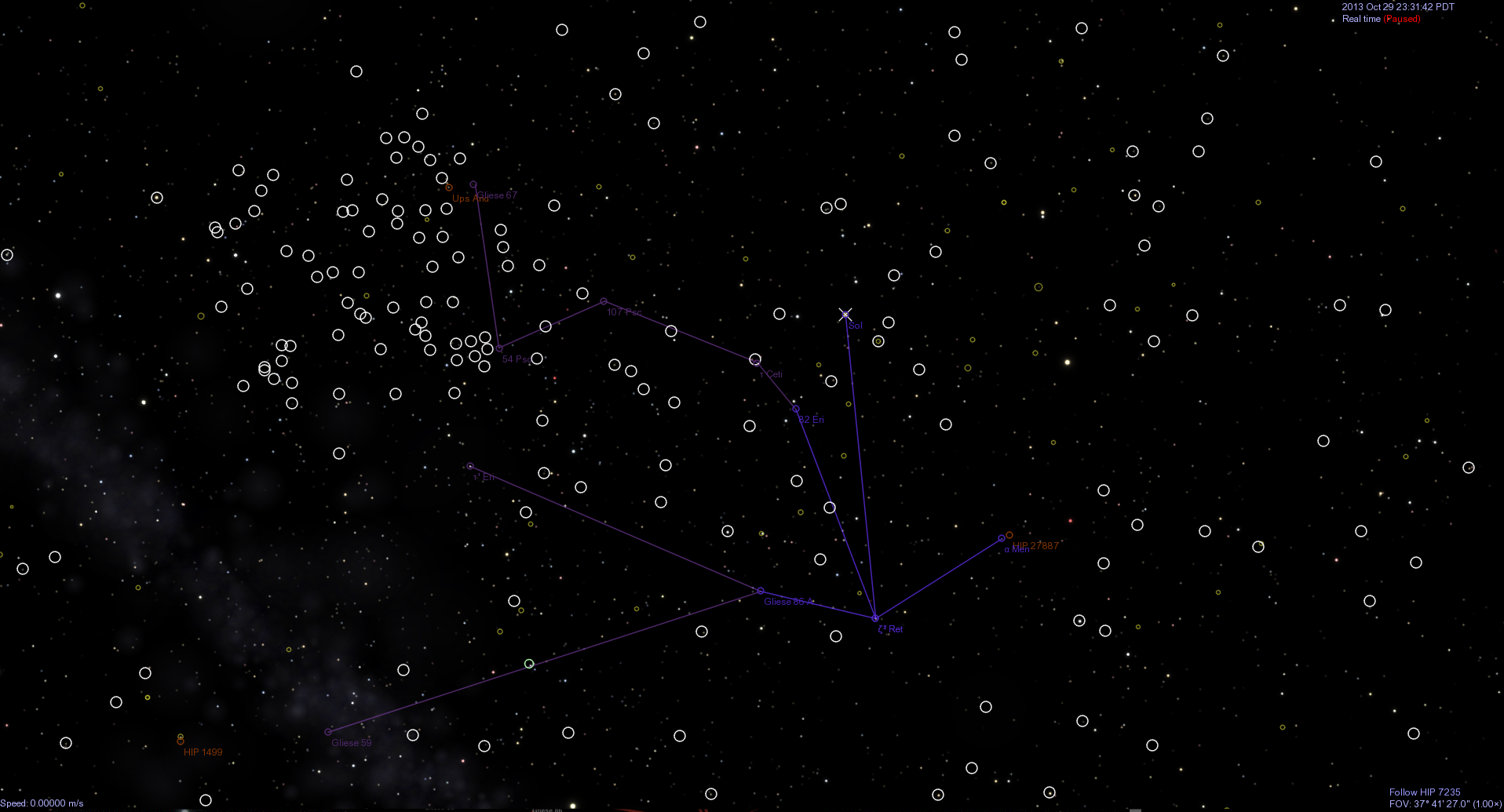
What do you think this map is showing?

The blue and purple lines appear to trace out the Marjorie Fish interpretation of the Betty Hill star map. An X marks the position of our Sun. I
conjecture that the hollow circles indicate the positions of other Sun-like stars of reasonably mature age; ones not previously associated with the
map. I see that quite a few of them are either on lines of the map, or along straight extensions of those lines. I surmise that these are actually
along the lines, not merely coincidentally aligned from the point of view of the map, so as to give this impression erroneously.
edit on
31-10-2013 by Ross 54 because: (no reason given)
The map seems to be showing Gliese 67 in the wrong position, and a mis-designated Gliese 59.
There is no Gliese 59; at least not just one. It seems there are at least 3: Gliese 59A, Gliese 59.1 and Gliese 59.2
The Gliese 59 in the Hill map can be either 59A, or 59.1.
What exactly did you use as a source?
There is no Gliese 59; at least not just one. It seems there are at least 3: Gliese 59A, Gliese 59.1 and Gliese 59.2
The Gliese 59 in the Hill map can be either 59A, or 59.1.
What exactly did you use as a source?
I see Gliese 67, correctly labeled as such, at the end of the uppermost route from Zeta Reticuli 2 in the map, where it belongs. Gliese 59 A is the primary component of the Gliese 59 multiple star system. Other stars in this system would be labeled with the following letters, in alphabetical order, B, and C ,and so on (as needed). Gliese 59.1 and 59.2 are two entirely different stars, one in the constellation Cassiopeia, and the other in Cetus, like Gliese 59, but at 96 light years distance, as opposed to 62 l.y. for Gliese 59. As far as I know Gliese 59 is the star system interpreted to be at the end of the bottom fork of the lower route on the map.
tanka418
The map seems to be showing Gliese 67 in the wrong position, and a mis-designated Gliese 59.
There is no Gliese 59; at least not just one. It seems there are at least 3: Gliese 59A, Gliese 59.1 and Gliese 59.2
The Gliese 59 in the Hill map can be either 59A, or 59.1.
What exactly did you use as a source?
reply to post by Ross 54
Gliese 67 is not in the correct place. Go back a few pages and look at the image I posted.
Gliese 67 is in the Andromeda constellation, which is a "fair piece" from where it is sown in the map in question, and thus, doesn't even belong on the map and can't be used for map verification. Though it only represents about a 7% error.
And, "which" Gliese "59" was NEVER specified. This is actually another problem area, the precise star can not be specified due to lack of data; this leaves us with two choices; my map...Gliese 59.1, JadeStar's Gliese 59A. Both are close enough to call them a "hit", but either way additional "distortion is introduced.
Now as far as the actual positioning of Gilese 67. I ran the conversion from RA / Decl to XYZ personally. Originally I thought there must be something wrong with the algorithm I was using to compute star position, but that turned out to not be the case (all other stars are correct). The only other possibility would be bad data, but that checks out as well (across several sources). So, I am rather confidant that my map is the correct one. I've seen no evidence to contradict the placement of Gliese 67 on my map.
Gliese 67 is not in the correct place. Go back a few pages and look at the image I posted.
Gliese 67 is in the Andromeda constellation, which is a "fair piece" from where it is sown in the map in question, and thus, doesn't even belong on the map and can't be used for map verification. Though it only represents about a 7% error.
And, "which" Gliese "59" was NEVER specified. This is actually another problem area, the precise star can not be specified due to lack of data; this leaves us with two choices; my map...Gliese 59.1, JadeStar's Gliese 59A. Both are close enough to call them a "hit", but either way additional "distortion is introduced.
Now as far as the actual positioning of Gilese 67. I ran the conversion from RA / Decl to XYZ personally. Originally I thought there must be something wrong with the algorithm I was using to compute star position, but that turned out to not be the case (all other stars are correct). The only other possibility would be bad data, but that checks out as well (across several sources). So, I am rather confidant that my map is the correct one. I've seen no evidence to contradict the placement of Gliese 67 on my map.
tanka418
reply to post by Ross 54
Gliese 67 is not in the correct place. Go back a few pages and look at the image I posted.
Gliese 67 is in the Andromeda constellation, which is a "fair piece" from where it is sown in the map in question, and thus, doesn't even belong on the map and can't be used for map verification. Though it only represents about a 7% error.
And, "which" Gliese "59" was NEVER specified. This is actually another problem area, the precise star can not be specified due to lack of data; this leaves us with two choices; my map...Gliese 59.1, JadeStar's Gliese 59A. Both are close enough to call them a "hit", but either way additional "distortion is introduced.
Thanks tanka! You rock!
That is exactly the case. I was going to point that out in a subsequent post.
By the way, I've set a deadline which I am going to meet, even if it means staying up all night this weekend, to get the video and the new thread up by Sunday.
One reason for that follows.
NASA is holding its 2nd Kepler Science Conference next week from Nov 4-8 at NASA Ames Research Center at Moffat Field in California.
On Tuesday there will be a public lecture which astronomer Frank Drake (of "Drake Equation" fame) will be giving on "Kepler and Its Impact on the Search for Extraterrestrial Intelligence" 7 pm in building 152. Tickets for this ***free*** event can be reserved HERE.
I encourage any of you if you are in that area of California and interested in this stuff to go if possible.
There will be a Q&A afterwards and the whole event is going to be streamed HERE and HERE.
I'll post these links in the new thread on Sunday and post any relevant news from the conference as it occurs in the same thread.
My goal is to give lay everything out in the new thread in a nice concise manner with the video in the first post. Anyone new to the thread will have a fair amount of time to go over the information before perhaps asking Dr. Drake about any of it if they go to Moffat Field.
More information here: nexsci.caltech.edu... and here (includes map to the event): drakeonkepler.eventbrite.com...
Ross 54
The blue and purple lines appear to trace out the Marjorie Fish interpretation of the Betty Hill star map.
Correct.
An X marks the position of our Sun.
Also correct.
I conjecture that the hollow circles indicate the positions of other Sun-like stars of reasonably mature age; ones not previously associated with the map.
Close. The hollow white circles indicate confirmed planetary systems not previously associated with the map.
I see that quite a few of them are either on lines of the map, or along straight extensions of those lines. I surmise that these are actually along the lines, not merely coincidentally aligned from the point of view of the map, so as to give this impression erroneously.edit on 31-10-2013 by Ross 54 because: (no reason given)
Exactly. This was one of the first patterns which jumped out at me. It becomes even more stark when I overlay all of our SETI targeted searches (in other colors - which I will do later today). Our searches have been confined mostly to the right side of that map.
Top 100 Star list from the Proposed (and Cancelled) NASA Terrestrial Planet Finder mission:
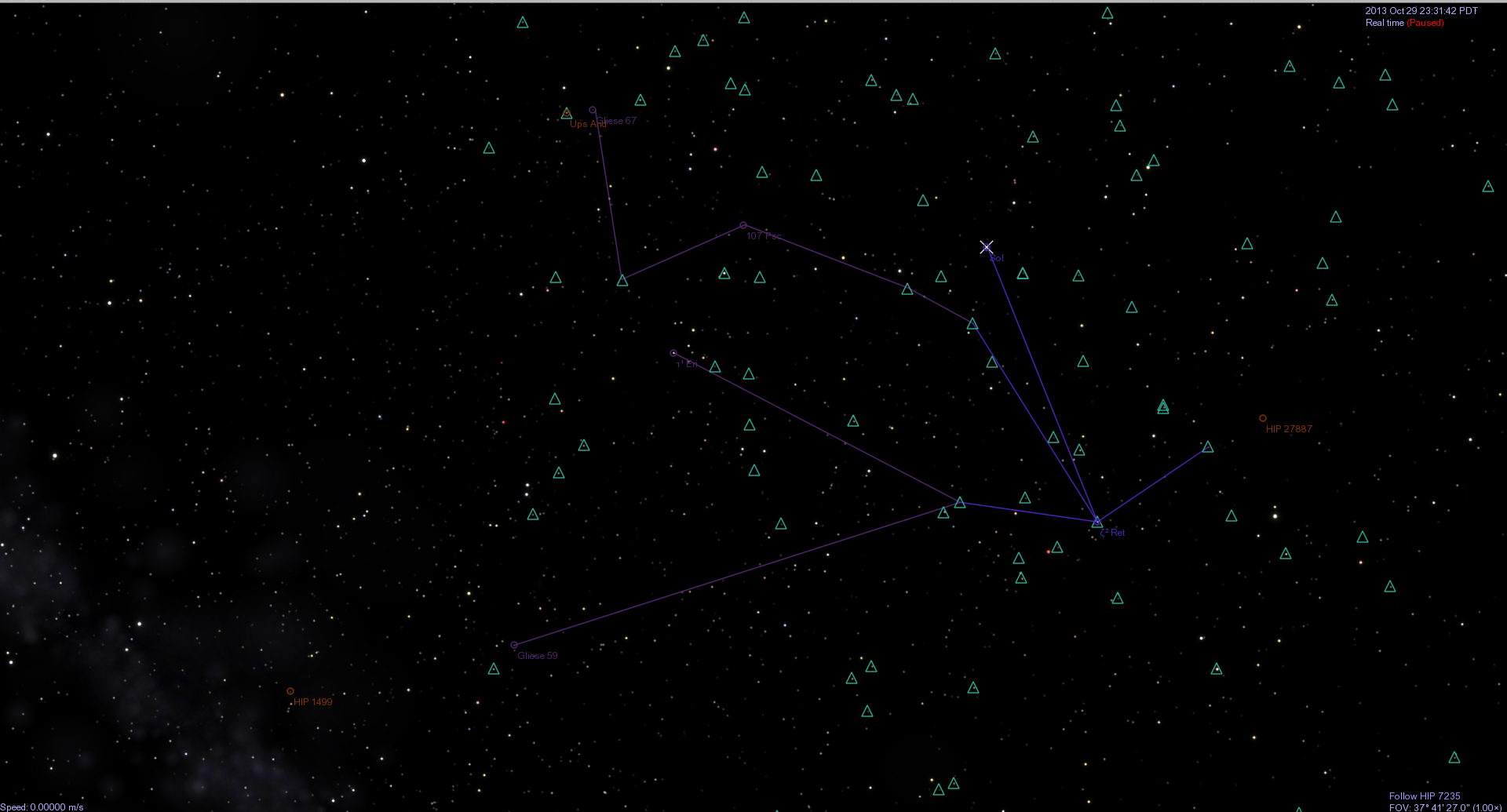
Actual planetary systems found so far (excluding the stars on the Hill-FIsh Map):
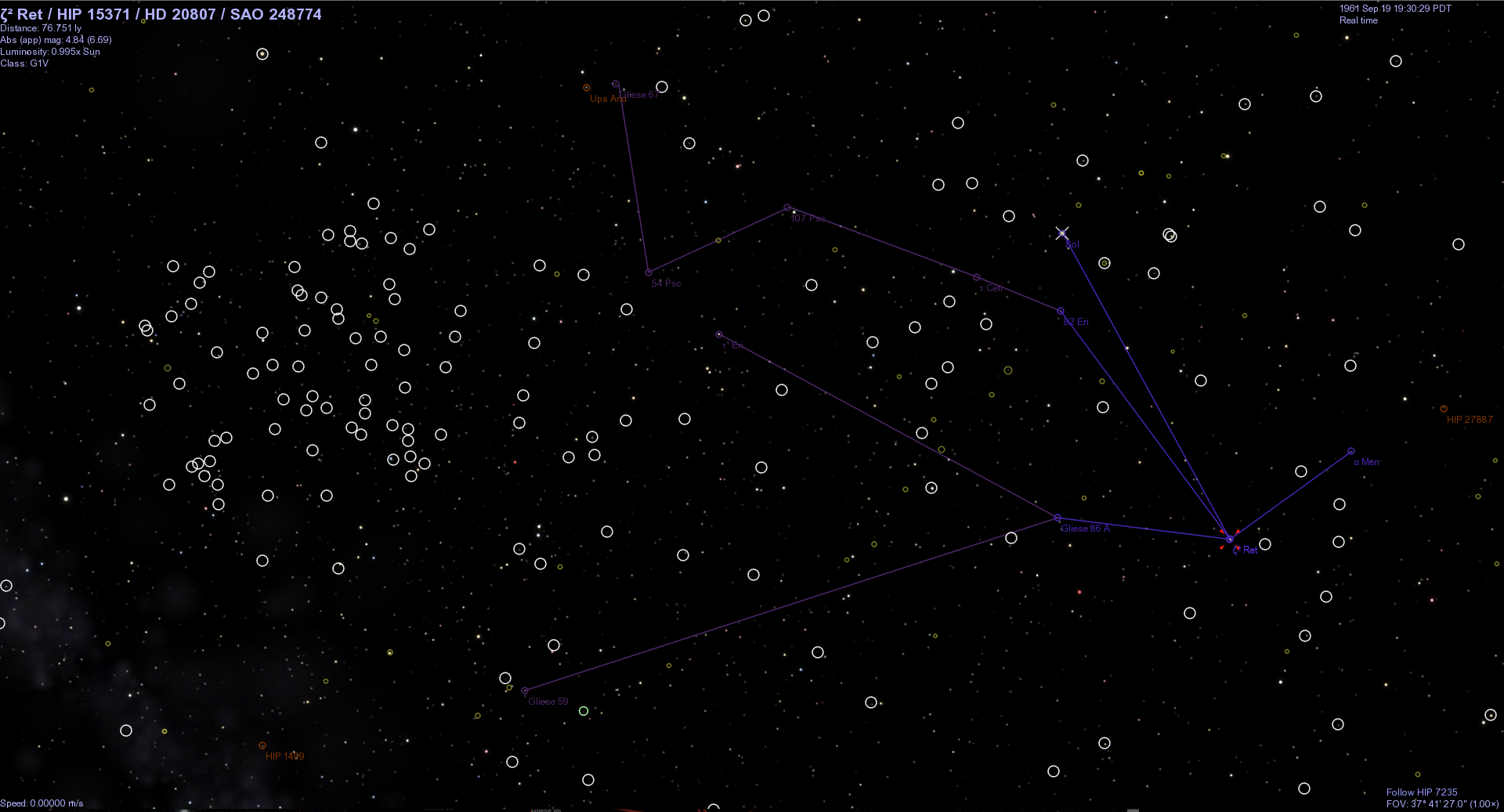
Why it's almost as if the "aliens" had better knowledge in 1961 about planetary systems around other stars than we did until recently.
Which is just what you'd expect were the map real.
This is not the only correlation that gives the map an air of reality. Here is yet another....
I wrote a script that can highlight a set of stars around a base star system out to different distances in a sphere shape. It draws red boxes around the stars.
Here are the stars within 20 light years of our Sun and Earth:
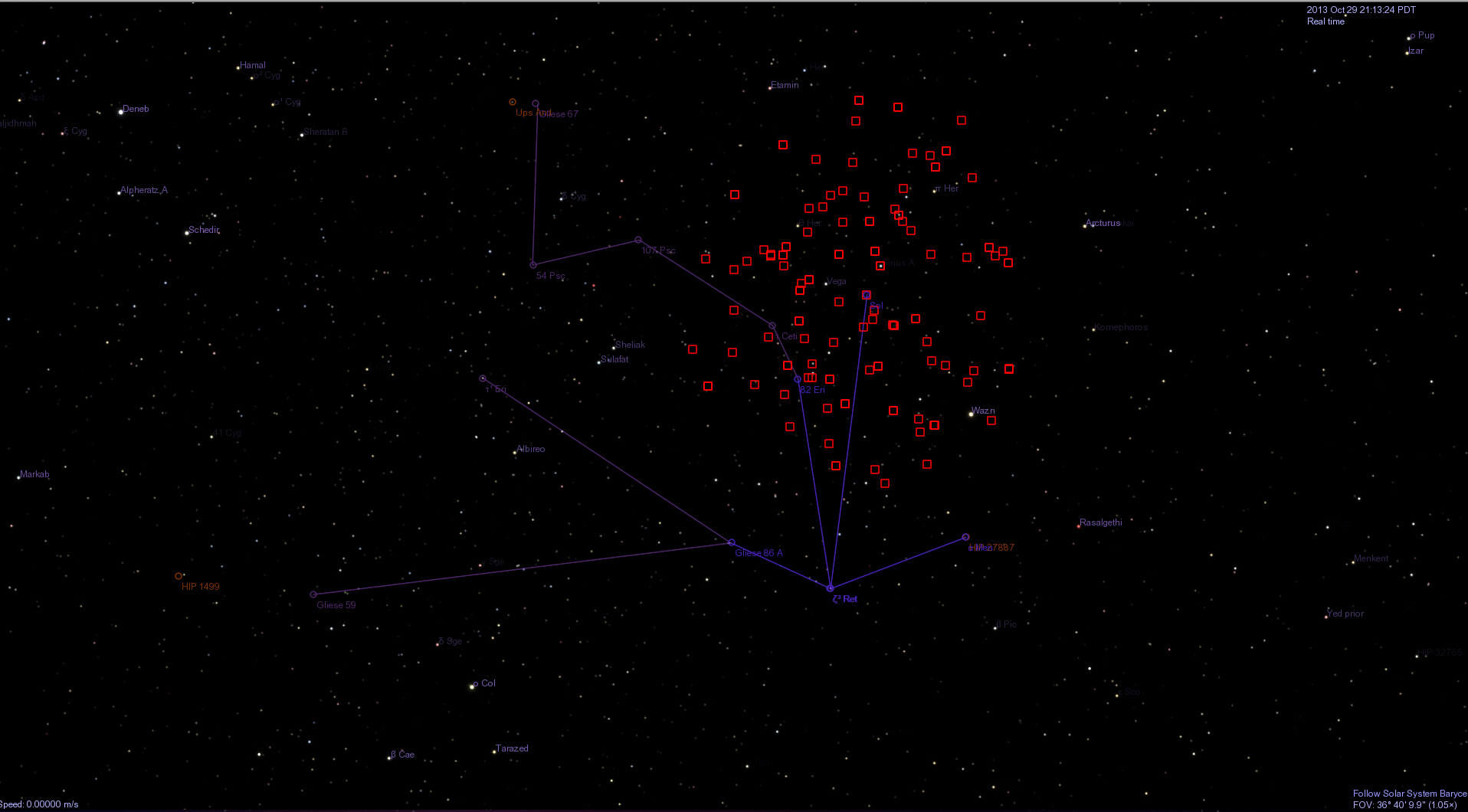
And here are the stars within 20 light years of Zeta 1 and Zeta 2 Reticuli:

Yet another answer as to why "they" would be exploring in the directions indicated on the map. Because the stars are closer and closer together.
Which is exactly what one would expect when a species was starting interstellar travel. Why try to fly across the ocean when you can island hop?

Or: Why try to jump on the freeway to the 'burbs if you don't have a good reason to go there when you can do all your shopping on foot in the city?'
Combining both the map of their nearby stars to the ones we know have planetary systems you get this...
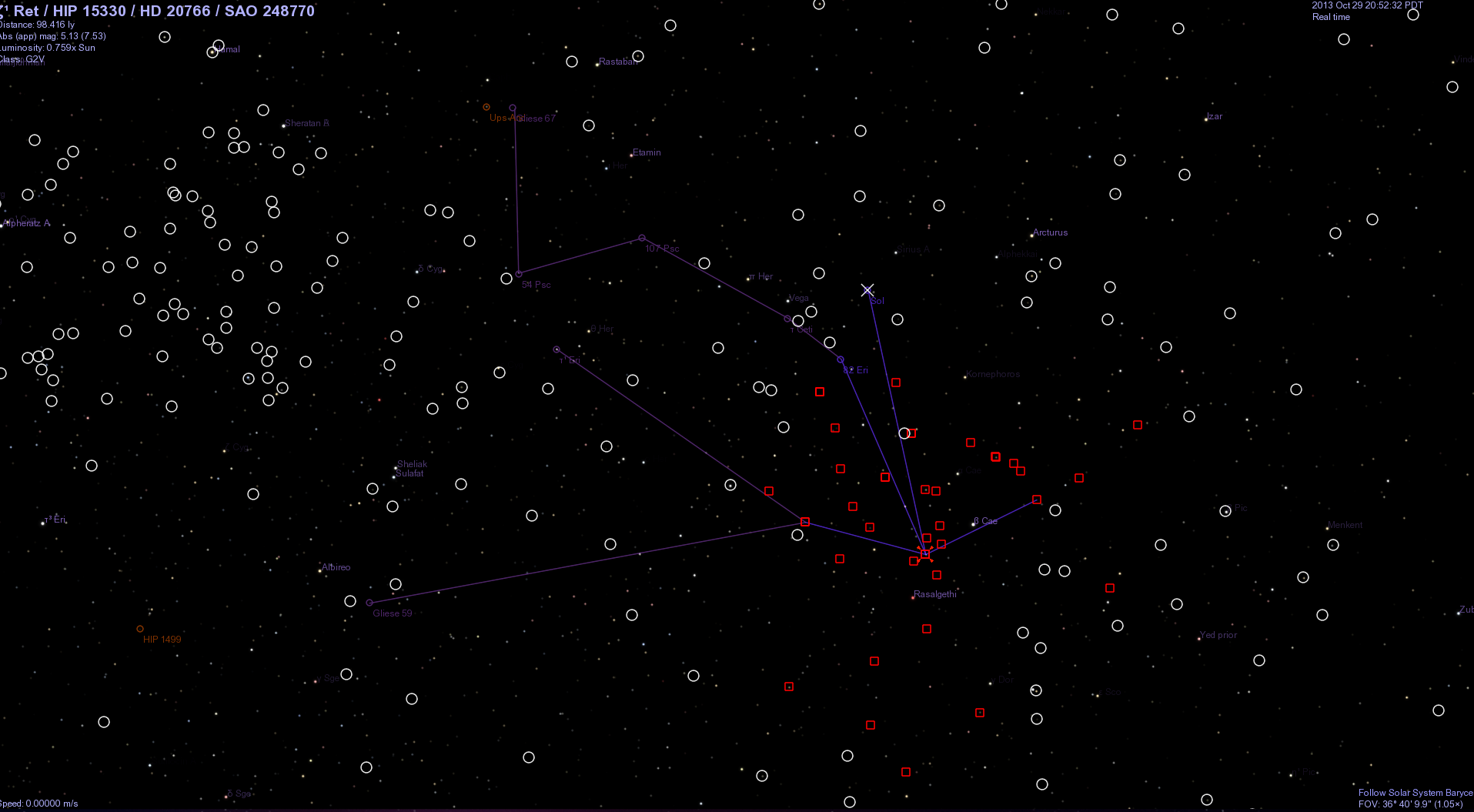
The whole thing gets even more curious when mixing in other data, which I'll get to before Sunday.
edit on 1-11-2013 by JadeStar because: (no
reason given)
JadeStar
Thanks tanka! You rock!
That is exactly the case. I was going to point that out in a subsequent post.
By the way, I've set a deadline which I am going to meet, even if it means staying up all night this weekend, to get the video and the new thread up by Sunday.
Interesting timing. I've started a wee project to build an accurate 3D map of space out to about 70 ly. that is some 1160 or so stars.
I've already developed the Python script to create an object, size, color, and position in Poser Pro. My next step is to add a small windows app to retrieve position data for all those stars from a database I put together a while back and place the in a Poser Scene. Unfortunately I don't have a very complete "ProperName" table (only 870 or so stars) so there may be a wee bit of work to fill in the unknown data. I was thinking along the lines of a web based interactive based on the map.
tanka418
JadeStar
Thanks tanka! You rock!
That is exactly the case. I was going to point that out in a subsequent post.
By the way, I've set a deadline which I am going to meet, even if it means staying up all night this weekend, to get the video and the new thread up by Sunday.
Interesting timing. I've started a wee project to build an accurate 3D map of space out to about 70 ly. that is some 1160 or so stars.
I've already developed the Python script to create an object, size, color, and position in Poser Pro. My next step is to add a small windows app to retrieve position data for all those stars from a database I put together a while back and place the in a Poser Scene. Unfortunately I don't have a very complete "ProperName" table (only 870 or so stars) so there may be a wee bit of work to fill in the unknown data. I was thinking along the lines of a web based interactive based on the map.
Interesting. You should go through the Celestia code over on Sourceforge. I'm pretty sure what you need is there since they basically already did what you're trying to do (out to a much greater distance) but they do not have a web interface. So perhaps all you have to do is create a Java version of Celestia?
sourceforge.net...
Here's the map including almost all of the major SETI searches and the confirmed extrasolar planetary systems:

O - Circles = NASA HRMS (SETI) 80s-mid 90s
O - Light Green Circles= SETI Institute's Project Phoenix at Green Bank, WV
O - Pink Circles = SETI Institute's Project Phoenix at Parkes, Australia
O - Red Circles = SETI Institute's Project Phoenix at Arecibo
O -White Circles = Confirmed Planetary Systems other than star on the Hill Map.
Unfortunately I can not plot the observation list for the current Allen Telescope Array based search because SETI no longer publishes the lists of stars they observe like they did through the 90s and early part of the last decade.
You may note that they observed Zeta Reticuli only during the Parkes, Australia run as these two stars sit in a part of the sky only observable from the Earth's southern hemisphere.
Next I will try to put together a short video so you can see where all of that fits in the context of our Milky Way Galaxy (in preparation for the Hill-Fish Map video tour).

O - Circles = NASA HRMS (SETI) 80s-mid 90s
O - Light Green Circles= SETI Institute's Project Phoenix at Green Bank, WV
O - Pink Circles = SETI Institute's Project Phoenix at Parkes, Australia
O - Red Circles = SETI Institute's Project Phoenix at Arecibo
O -White Circles = Confirmed Planetary Systems other than star on the Hill Map.
Unfortunately I can not plot the observation list for the current Allen Telescope Array based search because SETI no longer publishes the lists of stars they observe like they did through the 90s and early part of the last decade.
You may note that they observed Zeta Reticuli only during the Parkes, Australia run as these two stars sit in a part of the sky only observable from the Earth's southern hemisphere.
Next I will try to put together a short video so you can see where all of that fits in the context of our Milky Way Galaxy (in preparation for the Hill-Fish Map video tour).
edit on 2-11-2013 by JadeStar because: (no reason given)
new topics
-
Has Tesla manipulated data logs to cover up auto pilot crash?
Automotive Discussion: 43 minutes ago -
whistleblower Captain Bill Uhouse on the Kingman UFO recovery
Aliens and UFOs: 5 hours ago -
1980s Arcade
General Chit Chat: 7 hours ago -
Deadpool and Wolverine
Movies: 8 hours ago -
Teenager makes chess history becoming the youngest challenger for the world championship crown
Other Current Events: 9 hours ago -
CIA botched its handling of sexual assault allegations, House intel report says
Breaking Alternative News: 10 hours ago
top topics
-
Lawsuit Seeks to ‘Ban the Jab’ in Florida
Diseases and Pandemics: 13 hours ago, 20 flags -
Starburst galaxy M82 - Webb Vs Hubble
Space Exploration: 15 hours ago, 13 flags -
The Superstition of Full Moons Filling Hospitals Turns Out To Be True!
Medical Issues & Conspiracies: 16 hours ago, 8 flags -
CIA botched its handling of sexual assault allegations, House intel report says
Breaking Alternative News: 10 hours ago, 8 flags -
15 Unhealthiest Sodas On The Market
Health & Wellness: 15 hours ago, 6 flags -
whistleblower Captain Bill Uhouse on the Kingman UFO recovery
Aliens and UFOs: 5 hours ago, 6 flags -
1980s Arcade
General Chit Chat: 7 hours ago, 4 flags -
Deadpool and Wolverine
Movies: 8 hours ago, 3 flags -
Teenager makes chess history becoming the youngest challenger for the world championship crown
Other Current Events: 9 hours ago, 3 flags -
Has Tesla manipulated data logs to cover up auto pilot crash?
Automotive Discussion: 43 minutes ago, 0 flags
active topics
-
Has Tesla manipulated data logs to cover up auto pilot crash?
Automotive Discussion • 1 • : andy06shake -
15 Unhealthiest Sodas On The Market
Health & Wellness • 36 • : tanstaafl -
My wife just had a very powerful prophetic dream - massive war in Israel...
The Gray Area • 12 • : SchrodingersRat -
-@TH3WH17ERABB17- -Q- ---TIME TO SHOW THE WORLD--- -Part- --44--
Dissecting Disinformation • 606 • : burritocat -
"We're All Hamas" Heard at Columbia University Protests
Social Issues and Civil Unrest • 199 • : FlyersFan -
It takes One to Be; Two to Tango; Three to Create.
Philosophy and Metaphysics • 7 • : Terpene -
Take it to the Media when you protest.. Don't let them ignore you!
Education and Media • 4 • : SchrodingersRat -
They Killed Dr. Who for Good
Rant • 62 • : FlyersFan -
Lawsuit Seeks to ‘Ban the Jab’ in Florida
Diseases and Pandemics • 22 • : Disgusted123 -
Definitive 9.11 Pentagon EVIDENCE.
9/11 Conspiracies • 421 • : Lazy88
